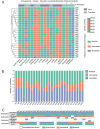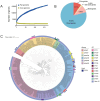Comparative genomic analysis of food-animal-derived and human-derived Clostridium perfringens isolates from markets in Shandong, China
- PMID: 40236475
- PMCID: PMC11996926
- DOI: 10.3389/fmicb.2025.1543511
Comparative genomic analysis of food-animal-derived and human-derived Clostridium perfringens isolates from markets in Shandong, China
Abstract
Clostridium perfringens (C. perfringens) is a foodborne pathogen that poses a significant threat to both animal husbandry and public health. In this study, 27 C. perfringens strains were isolated from animal samples and animal-derived food products. Antibiotics resistances among the isolates were phenotypically and genotypically analyzed and Whole genome sequencing (WGS). In combination with the genomes of 141 human-derived C. perfringens strains from public databases, this study conducted comprehensive analyses of antibiotic resistance genes, virulence genes, multilocus sequence typing (MLST), prophage detection, and pan-genome analysis for a total of 168 strains of C. perfringens. Antibiotics resistances among the isolates were phenotypically and genotypically analyzed and found 24 of them (88.9%, 24/27) were identified as multidrug-resistant (MDR). WGS analysis revealed that 13 strains belonged to known sequence types (ST), and the remaining strains represented 10 new STs. By analysis in combination with data of 141 C. perfringens isolates from the database, it was implied that ST221, ST72 and ST370 were present in both animal-derived and human-derived C. perfringens. It is worth noting that 108 out of 168 strains of C. perfringens (64.3%, 108/168) were found to carry prophages, which were found more prevalent in human-derived C. perfringens isolates. Pan-genome and phylogenetic analysis of 168 C. perfringens strains indicated that C. perfringens possesses an open pan-genome with genetic diversity. This study provides genomic insights into C. perfringens from food animals and humans, shedding light on the importance for monitoring the C. perfringens in livestock in China for better public health.
Keywords: Clostridium perfringens; multidrug-resistant bacteria; pangenome analysis; toxinotypes; whole genome sequencing.
Copyright © 2025 Zhu, Huang, Shi, Gao, Chen, Liu, Cao, Xue and Li.
Conflict of interest statement
XX was employed by Shandong Sinder Technology Co., Ltd. The remaining authors declare that the research was conducted in the absence of any commercial or financial relationships that could be construed as a potential conflict of interest.
Figures





References
-
- Abdel-Glil M. Y., Thomas P., Linde J., Busch A., Wieler L. H., Neubauer H., et al. (2021a). Comparative in silico genome analysis of Clostridium perfringens unravels stable phylogroups with different genome characteristics and pathogenic potential. Sci. Rep. 11:6756. 10.1038/s41598-021-86148-8 - DOI - PMC - PubMed
-
- Alcock B. P., Huynh W., Chalil R., Smith K. W., Raphenya A. R., Wlodarski M. A., et al. (2023). CARD 2023: Expanded curation, support for machine learning, and resistome prediction at the comprehensive antibiotic resistance database. Nucleic Acids Res. 51 D690–D699. 10.1093/nar/gkac920 - DOI - PMC - PubMed
LinkOut - more resources
Full Text Sources

